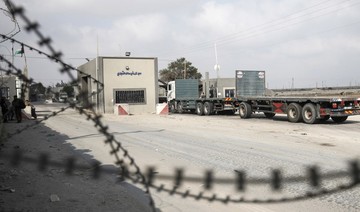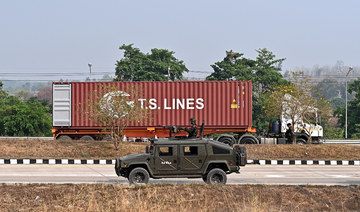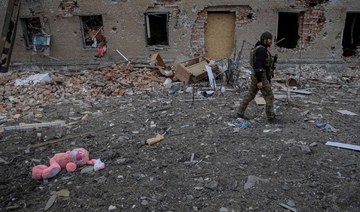WASHINGTON: The United States will merge the US Consulate General, which serves Palestinians, with its new embassy into a single diplomatic mission in Jerusalem, Secretary of State Mike Pompeo said on Thursday.
“This decision is driven by our global efforts to improve the efficiency and effectiveness of our operations,” Pompeo said in a statement. “It does not signal a change of US policy on Jerusalem, the West Bank, or the Gaza Strip.”
The consulate-general in Jerusalem is the top mission for Palestinians, who want East Jerusalem for their capital.
“We will continue to conduct a full range of reporting, outreach, and programming in the West Bank and Gaza as well as with Palestinians in Jerusalem through a new Palestinian Affairs Unit inside US Embassy Jerusalem,” Pompeo said.
He said the Trump administration was committed to a peace effort between Israel and the Palestinians.
US President Donald Trump outraged the Arab world and stoked international concern by recognizing Jerusalem as Israel’s capital in December and moving the US Embassy from Tel Aviv to Jerusalem in May.
The status of Jerusalem is one of the thorniest disputes between Israel and the Palestinians and Palestinian leaders accused Trump of sowing instability by overturning decades of US policy.
Palestinians, with broad international backing, seek East Jerusalem as the capital of a state they want to establish in the occupied West Bank and the Gaza Strip.
Israel regards all of the city, including the eastern sector it captured in the 1967 Middle East war and annexed, as its “eternal and indivisible capital,” but that is not recognized internationally. The Trump administration has avoided that description, and noted that the city’s final borders should be decided by the parties.
US to merge Jerusalem consulate in to new embassy
US to merge Jerusalem consulate in to new embassy

Bayer Leverkusen’s record unbeaten march continues with a 2-0 win at Roma in Europa League

- No club from Europe’s five biggest leagues — in Germany, England, Italy, Spain and France — has had a longer unbeaten streak
- The result also marked a measure of revenge for Leverkusen — since Roma had beaten the German club in this exact same stage last season for their last defeat in Europe
- In the other semifinal, Atalanta drew 1-1 at Marseille
ROME: An imposing stadium in a major foreign capital did nothing to stop Bayer Leverkusen’s record unbeaten march across Europe.
The freshly crowned first-time Bundesliga champions silenced the Stadio Olimpico with a 2-0 win at Roma in the first leg of the Europa League semifinals on Thursday to extend their unbeaten streak to 47 matches across all competitions.
No club from Europe’s five biggest leagues — in Germany, England, Italy, Spain and France — has had a longer unbeaten streak.
“We take things game by game and we are not thinking about being unbeaten,” Leverkusen midfielder Amine Adli said. “We are not thinking about making history or things like that — that’s why we are playing like this and the team is strong. We just want to enjoy ourselves.”
The result also marked a measure of revenge for Leverkusen — since Roma had beaten the German club in this exact same stage last season for their last defeat in Europe.
“We know it is not easy to play here,” Adli said. “We played a very serious game.”
Leverkusen’s last loss across all competitions was a 3-0 defeat to Bochum in the final round of last season’s Bundesliga nearly a year ago — on May 27, 2023.
Roma were dangerous with an early header off the crossbar from Romelu Lukaku. But then Leverkusen scored on the counterattack seven minutes later.
A failed back pass from Roma right back Rick Karsdorp under pressure from Alex Grimaldo on the left flank resulted in a 3-on-1 for Leverkusen. Grimaldo then passed to Florian Wirtz, who calmly slotted in from the center of the area.
Midfielder Robert Andrich added another goal for Leverkusen in the 73rd with a long-range shot — just as Roma had been threatening on the other end.
In the other semifinal, Atalanta drew 1-1 at Marseille.
The second legs will be held next Thursday, with the final to be held in Dublin on May 22.
Leverkusen has won only one European trophy: the 1988 UEFA Cup, which was then predecessor to the Europa League. Its only other European final came in the 2002 Champions League, won by Real Madrid.
Roma are aiming to qualify for their third consecutive European final after winning the Europa Conference League in 2022 and losing last year’s Europa League final to Sevilla in a penalty shootout.
Daniele De Rossi replaced Jose Mourinho as Roma’s coach in January.
The Giallorossi hadn’t lost a European knockout stage game at home in seven years — since getting beat 1-0 by Villarreal in the 2017 Europa League.
Roma fans’ pre-match choreography across one entire end of the stadium spelled out the word “AVANZIAMO” (“Let’s advance”). But Roma now face an uphill challenge to eliminate Leverkusen, who haven’t lost all season.
Marseille-Atalanta
Marseille’s players were treated to an ovation at Stade Velodrome from their hard-to-please fans after the draw with Atalanta — who eliminated Liverpool in the quarterfinals.
Atalanta took the lead in the 11th when striker Gianluca Scamacca hit a low shot into the bottom corner after reading Teun Koopmeiners’ clever pass.
But Marseille equalized in the 20th when central defender Chancel Mbemba collected Geoffrey Kondogbia’s pass and his fine curling shot from the edge of the penalty area hit the left post and rolled in.
The second half was almost entirely one-way traffic as Marseille pushed forward. Winger Ismaïla Sarr had a goal disallowed for an offside following a video review and substitute Azzedine Ounahi hit the crossbar with a curling shot in the 73rd.
Europa Conference League
In the third-tier competition semifinal first legs, Aston Villa’s hopes of reaching a first European final since 1982 were diminished with a 4-2 home loss to Olympiakos, the first defeat at Villa Park in the European campaign for the last English club in European competitions.
Villa came back from 2-0 down but were not able to answer Ayoub El Kaabi’s third goal of the game. The striker converted from the penalty spot to make it 3-2 for his eighth goal in the competition this season. Santiago Hezze finished the scoring before Douglas Luiz wasted a penalty for Villa.
Olympiakos are aiming to play on home soil in the May 29 final in Athens.
Earlier, El Kaabi scored twice within a half hour put the visitors in charge.
In Florence, substitute M’Bala Nzola netted in stoppage time for last-year’s runner-up Fiorentina to secure a 3-2 victory over 10-man Club Brugge.
Brugge’s Raphael Onyedika was sent off after receiving his second yellow card on the hour when the Italian club was 2-1 up but the visitors equalized through Igor Thiago to complete a counter just minutes later.
Riccardo Sottil put Fiorentina ahead early on, Brugge captain Hans Vanaken answered with an equalizer from the penalty spot and then Andrea Belotti restored the lead for Fiorentina on a rebound.
More than 2,100 people have been arrested during pro-Palestinian protests on US college campuses

- At least 50 incidents of arrests have happened at 40 different US colleges or universities since April 18
- The demonstrations began at Columbia on April 17 with students calling for an end to the Israel-Hamas war
LOS ANGELES: Police have arrested more than 2,100 people during pro-Palestinian protests at college campuses across the United States in recent weeks, sometimes using riot gear, tactical vehicles and flash-bang devices to clear tent encampments and occupied buildings. One officer fired his gun inside a Columbia University administration building while clearing out protesters camped inside, a prosecutor’s office confirmed.
No one was injured by the officer’s actions late Tuesday inside Hamilton Hall on the Columbia campus, according to Doug Cohen, a spokesperson for District Attorney Alvin Bragg’s office. Cohen said Thursday that the gun did not appear to be aimed at anyone, and that there were other officers but no students in the immediate vicinity. Bragg’s office is conducting a review, a standard practice.
More than 100 people were taken into custody during the Columbia crackdown, just a fraction of the total arrests stemming from recent campus protests over the Israel-Hamas war. A tally by The Associated Press on Thursday found at least 50 incidents of arrests at 40 different US colleges or universities since April 18.
Early Thursday, officers surged against a crowd of demonstrators at University of California, Los Angeles, ultimately taking at least 200 protesters into custody after hundreds defied orders to leave, some forming human chains as police fired flash-bangs to break up the crowds. Police tore apart a fortified encampment’s barricade of plywood, pallets, metal fences and dumpsters, then pulled down canopies and tents.
Like at UCLA, tent encampments of protesters calling on universities to stop doing business with Israel or companies they say support the war in Gaza have spread across other campuses nationwide in a student movement unlike any other this century. Iranian state television carried live images of the police action at UCLA, as did Qatar’s pan-Arab Al Jazeera satellite network. Live images of Los Angeles also played across Israeli television networks.
Israel has branded the protests antisemitic, while Israel’s critics say it uses those allegations to silence opposition. Although some protesters have been caught on camera making antisemitic remarks or violent threats, protest organizers — some of whom are Jewish — call it a peaceful movement to defend Palestinian rights and protest the war.
President Joe Biden on Thursday defended the right of students to peaceful protest but decried the disorder of recent days.
The demonstrations began at Columbia on April 17 with students calling for an end to the Israel-Hamas war, which has killed more than 34,000 Palestinians in the Gaza Strip, according to the Health Ministry there. Israel launched its offensive in Gaza after Hamas militants killed about 1,200 people, mostly civilians, on Oct. 7 and took roughly 250 hostages in an attack on southern Israel.
On April 18, the NYPD cleared Columbia’s initial encampment and arrested roughly 100 protesters. The demonstrators set up new tents and defied threats of suspension, and escalated their actions early Tuesday by occupying Hamilton Hall, an administration building that was similarly seized in 1968 by students protesting racism and the Vietnam War.
Roughly 20 hours later, officers stormed the hall. Video showed police with zip ties and riot shields streaming through a second-floor window. Police had said protesters inside presented no substantial resistance. At some point, the officer’s gun went off inside the building. Cohen, the DA’s spokesperson, did not provide additional details on the incident, which was first reported by news outlet The City on Thursday. The NYPD did not immediately respond to AP’s request for comment.
The confrontations at UCLA also played out over several days this week. UCLA Chancellor Gene Block told alumni on a call Thursday afternoon that the trouble started after a permitted pro-Israel rally was held on campus Sunday and fights broke out and “live mice” were tossed into the pro-Palestinian encampment later that day.
In the following days, administrators tried to find a peaceful solution with members of the encampment and expected things to remain stable, Block said.
That changed late Tuesday, he said, when counterdemonstrators attacked the pro-Palestinian encampment. Campus administrators and police did not intervene or call for backup for hours. No one was arrested that night, but at least 15 protesters were injured. The delayed response drew criticism from political leaders, including California Gov. Gavin Newsom, and officials pledged an independent review.
“We certainly weren’t thinking that we’d end up with a large number of violent people, that hadn’t happened before,” Block said on the call.
By Wednesday, the encampment had become “much more of a bunker” and there was no other solution but to have police dismantle it, he said.
The hourslong standoff went into Thursday morning as officers warned over loudspeakers that there would be arrests if the crowd — at the time more than 1,000 strong inside the encampment as well as outside of it — did not disperse. Hundreds left voluntarily, while another 200-plus remained and were ultimately taken into custody.
Meanwhile, protest encampments at other schools across the US have been cleared by police — resulting in more arrests — or closed up voluntarily. But University of Minnesota officials reached an agreement with protesters not to disrupt commencements, and similar compromises have been made at Northwestern University in suburban Chicago, Rutgers University in New Jersey and Brown University in Rhode Island.
Ariel Dardashti, a graduating UCLA senior studying global studies and sociology, said no student should feel unsafe at school.
“It should not get to the point where students are being arrested,” Dardashti said on campus Thursday.
Israel builds ‘cyber dome’ against Iran’s hackers

- Israeli cybersecurity agency had thwarted around 800 significant attacks since the Oct. 7 Gaza war erupted
- But some attacks could not be foiled, including against hospitals in which patient data was stolen
TEL AVIV: Israel’s Iron Dome defense system has long shielded it from incoming rockets. Now it is building a “cyber dome” to defend against online attacks, especially from arch foe Iran.
“It is a silent war, one which is not visible,” said Aviram Atzaba, the Israeli National Cyber Directorate’s head of international cooperation.
While Israel has fought Hamas in Gaza since the October 7 attack, it has also faced a significant increase in cyberattacks from Iran and its allies, Atzaba said.
“They are trying to hack everything they can,” he told AFP, pointing to Hamas and Lebanon’s Hezbollah movement but adding that so far “they have not succeeded in causing any real damage.”
He said around 800 significant attacks had been thwarted since the war erupted. Among the targets were government organizations, the military and civil infrastructure.
Some attacks could not be foiled, including against hospitals in the cities of Haifa and Safed in which patient data was stolen.
While Israel already has cyber defenses, they long consisted of “local efforts that were not connected,” Atzaba said.
So, for the past two years, the directorate has been working to build a centralized, real-time system that works proactively to protect all of Israeli cyberspace.
Based in Tel Aviv, the directorate works under the authority of the prime minister. It does not reveal figures on its staff, budget or computing resources.
Israel collaborates closely with multiple allies, including the United States, said Atzaba, because “all states face cyber terrorism.”
“It takes a network to fight a network,” he said.
Israel’s arch foe Iran is “an impressive enemy” in the online wars, said Chuck Freilich, a researcher at the Institute for National Security Studies, which is affiliated with Tel Aviv University.
“Its attacks aim to sabotage and destroy infrastructure, but also to collect data for intelligence and spread false information for propaganda purposes,” he said.
Iran has welcomed Hamas’s October 7 attack on Israel, which resulted in the deaths of 1,170 people, mostly civilians, according to an AFP tally based on Israeli official figures.
Israel’s retaliatory offensive against Hamas has killed at least 34,596 people in Gaza, mostly women and children, according to the Hamas-run territory’s health ministry.
Regional tensions have soared, particularly after Iran for the first time fired hundreds of missiles directly at Israel last month in retaliation for a deadly Israeli air strike on the Iranian consulate in Damascus.
It was the most dramatic escalation yet after a years-long shadow war of killings and sabotage attacks between Israel and Iran.
Freilich argued in a study published in February that Iran was relatively slow to invest in cyberwarfare, until two key events triggered a change.
First, its leaders took note of how anti-government protesters used the Internet as a tool to mobilize support for a 2009 post-election uprising.
In the bloody crackdown that crushed the movement, Iran’s authorities cut access to social media and websites covering the protests.
Then, in September 2010, a sophisticated cyberattack using the Stuxnet virus, blamed by Iran on Israel and the United States, caused physical damage to Tehran’s nuclear program.
Freilich said the attack “demonstrated Iran’s extreme vulnerability and led to a severe national shock.”
Since then, Iran has gained substantial expertise to become “one of the most active countries in cyberspace,” he said
While Israel is considered a major cyber power, Iran was only likely to improve, said Freilich.
He pointed to assistance from Russia and China, as well as its much larger population and an emphasis on cyber training for students and soldiers alike, adding that the trend was “concerning for the future.”
Atzaba insisted that the quantity of hackers is secondary to the quality of technology and the use it is put to.
“For the past two years, we have been developing a cyber dome against cyberattacks, which functions like the Iron Dome against rockets,” he said.
“With cyber dome, all sources are fed into a large data pool that enables a view of the big picture and to invoke a national response in a comprehensive and coordinated manner.”
The Israeli system has various scanners that continuously “monitor Israeli cyberspace for vulnerabilities and informs the stakeholders of the means to mitigate them,” he said.
Israel’s cyber strength relied on close cooperation between the public, private and academic sectors, as well as Israel’s “white hat” hackers who help identify weaknesses.
“We work hand in hand,” he said.
Myanmar junta bans men from applying to work abroad

- Ruling junta's plan to call up all men to serve in the military for at least two years has sent thousands queuing for visas outside foreign embassies in Yangon
YANGON: Myanmar’s junta has suspended the issuing of permits for men to work abroad, it said, weeks after introducing a military conscription law that led to thousands trying to leave the country.
The junta, which is struggling to crush widespread armed opposition to its rule, in February said it would enforce a law allowing it to call up all men to serve in the military for at least two years.
The move sent thousands queuing for visas outside foreign embassies in Yangon and others crossing into neighboring Thailand to escape the law, according to media reports.
The labor ministry has “temporarily suspended” accepting applications from men who wish to work abroad, the ministry said in a statement posted by the junta’s information team late Thursday.
The measure was needed to “take more time to verify departure processes and according to other issues,” it said, without giving details.
More than 4 million Myanmar nationals were working abroad in 2020, according to an estimate by the International Labour Organization citing figures from the then-government.
Analysts say many more work abroad off the books.
The military service law was authored by a previous junta in 2010 but was never brought into force.
It allows the military to summon all men aged 18-35 and women aged 18-27 to serve for at least two years.
That law also has a stipulation that, during a state of emergency, the terms of service can be extended up to five years and those ignoring a summons to serve can be jailed for the same period.
The Myanmar junta announced a state of emergency when it seized power in 2021, with the army recently extending it for a further six months.
A first batch of several thousand recruits has already begun training under the law, according to pro-military Telegram accounts.
A junta spokesman said the law was needed “because of the situation happening in our country,” as it battles both so-called People’s Defense Forces and more long-standing armed groups belonging to ethnic minorities.
Around 13 million people will be eligible to be called up, he said, though the military only has the capacity to train 50,000 a year.
More than 4,900 people have been killed in the military’s crackdown on dissent since its February 2021 coup and more than 26,000 others arrested, according to a local monitoring group.
Send us Patriots: Ukraine’s battered energy plants seek air defenses against Russian attacks

- Ukraine's foreign minister has said half of the country’s energy system has been damaged by Russian attacks
- Russian President Vladimir Putin has framed the attacks as retaliation for Ukrainian strikes on Russian oil refineries
KYIV, Ukraine: At a Ukrainian power plant repeatedly hit by Russian aerial attacks, equipment department chief Oleh has a one-word answer when asked what Ukraine’s battered energy industry needs most: “Patriot.”
Ukrainian energy workers are struggling to repair the damage from intensifying airstrikes aimed at pulverizing Ukraine’s energy grid, hobbling the economy and sapping the public’s morale. Staff worry they will lose the race to prepare for winter unless allies come up with air-defense systems like the US-made Patriots to stop Russian attacks inflicting more destruction on already damaged plants.
“Rockets hit fast. Fixing takes long,” Oleh said in limited but forceful English.
The US has sent Ukraine some Patriot missile systems, and said last week it would give more after entreaties from President Volodymyr Zelensky.
The Associated Press on Thursday visited a plant owned by DTEK, the country’s biggest private energy supplier, days after a cruise-missile attack left parts of it a mess of smashed glass, shattered bricks and twisted metal. The coal-fired plant is one of four DTEK power stations struck on the same day last week.
The AP was given access on the condition that the location of the facility, technical details of the damage and workers’ full names are not published due to security concerns.
During the visit, State Emergency Service workers in hard hats and harnesses clambered atop the twisted roof of a vast building, assessing the damage and occasionally dislodging chunks of debris with a thunderous clang.
Ukrainian Foreign Minister Dmytro Kuleba told Foreign Policy magazine that half of the country’s energy system has been damaged by Russian attacks.
DTEK says it has lost 80 percent of its electricity-generating capacity in almost 180 aerial attacks since the start of Russia’s full-scale invasion in 2022. It estimates that repairing all the damaged plants would take between six months and two years — even if there are no more strikes.
Shift supervisor Ruslan was on duty in the operations room when the air alarm sounded. He sent his crew to a basement shelter but remained at his post when the blast struck only meters (yards) away.
He rushed out to darkness, dust and fire. He said he wasn’t scared because “I knew what I needed to do” – make sure his team was OK and then try to help put out the flames.
Russia pummeled Ukraine’s energy infrastructure to devastating effect during the “blackout winter” of 2022-23. In March it launched a new wave of attacks, one of which completely destroyed the Trypilska power plant near Kyiv, one of the country’s biggest.
Russian President Vladimir Putin has framed the attacks as retaliation for Ukrainian strikes on Russian oil refineries.
Oleh said the Russians are “learning all the time” and adapting their tactics. Initially they targeted transformers that distribute power; now they aim for the power-generating equipment itself, with increasing accuracy. The Russians also are sending growing numbers of missiles and exploding drones to exhaust Ukraine’s air defenses, and striking the same targets repeatedly.
DTEK executive director Dmytro Sakharuk said in March that out of 10 units the company had repaired after earlier strikes, two-thirds had been hit again.
More Russian missiles have been getting through in recent months as Ukraine awaited new supplies from allies, including a $61 billion package from the US that was held up for months by wrangling in Congress. It was finally approved in April, but it could be weeks or months before all the new weapons and ammunition arrives.
Ukraine’s energy firms have all but exhausted their finances, equipment and spare parts fixing the damage Russia has already wrought. The country’s power plants urgently need specialist equipment that Ukraine can no longer make at sufficient speed and scale.
Some 51 DTEK employees have been wounded in attacks since 2022, and three have been killed. Staff say they keep working despite the danger because they know how crucial their work is.
Machine operator Dmytro, who was on shift during the recent attack and took shelter in the basement, said that when he emerged, “my soul was bleeding when I saw the scale of the destruction.”
He thought of the many people who had poured heart and soul into building the mammoth power plant.
“This was destroyed in a few seconds, in an instant,” he said.
Dmytro, who worked at Ukraine’s Zaporizhzhia nuclear power plant before it was seized by Russia, said he would continue to show up for work every day, “as long as I’m able.”
“It’s our duty toward the country,” he said





















